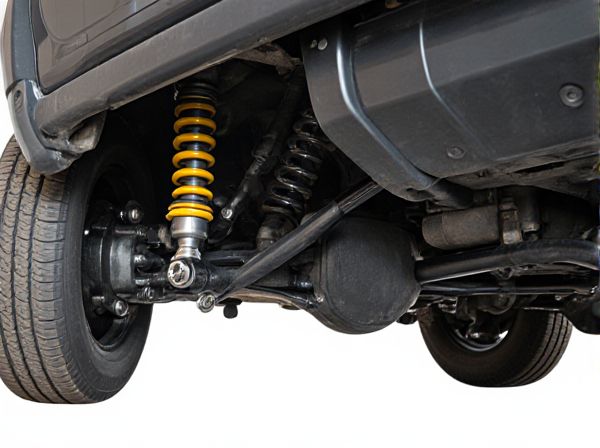
Photo illustration: Solid Axle vs Independent Rear Suspension
Solid axle suspensions provide durability and better load-bearing capacity, making them ideal for off-road and heavy-duty applications. Independent rear suspensions offer improved ride comfort and handling by allowing each wheel to move independently, enhancing traction and stability on uneven surfaces. Choosing the right setup depends on whether you prioritize rugged performance or smooth driving experience for your vehicle.
Table of Comparison
| Feature | Solid Axle | Independent Rear Suspension (IRS) |
|---|---|---|
| Design | Rigid axle connecting both wheels | Each wheel moves independently |
| Ride Comfort | Less comfortable over bumps | Improved comfort and smoother ride |
| Handling | Less precise handling | Better handling and traction |
| Durability | Robust and strong for heavy loads | More complex, potential for increased maintenance |
| Cost | Less expensive to manufacture and repair | Higher manufacturing and repair costs |
| Weight | Heavier system | Lighter overall weight |
| Usage | Common in trucks and off-road vehicles | Used in performance and luxury vehicles |
Introduction to Rear Suspension Systems
Rear suspension systems are critical for vehicle stability, handling, and ride comfort by managing how the rear wheels react to road conditions. Solid axles feature a single rigid beam connecting both rear wheels, providing durability and strength ideal for heavy-duty and off-road vehicles. Independent rear suspension allows each wheel to move independently, enhancing ride quality and handling performance in passenger cars and sports vehicles.
What is a Solid Axle?
A solid axle, also known as a live axle, is a suspension design where both rear wheels are connected by a single, rigid beam that moves as a unit. This setup provides durability and is commonly used in trucks and off-road vehicles for better load-bearing capacity and traction on uneven terrain. Compared to independent rear suspension, solid axles tend to offer simpler maintenance and increased strength but may deliver a rougher ride and less precise handling.
What is Independent Rear Suspension (IRS)?
Independent Rear Suspension (IRS) allows each rear wheel to move independently, improving ride comfort and handling by reducing unsprung weight and minimizing road shock transfer. Unlike a solid axle, IRS uses multiple linkages and coil springs or air springs to provide better traction and stability on uneven terrain. This suspension design enhances vehicle control and performance, especially in passenger cars and off-road vehicles.
Key Differences Between Solid Axle and IRS
Solid axle suspension features a single, rigid beam connecting both rear wheels, offering superior durability and load-carrying capacity, ideal for off-road and heavy-duty applications. Independent rear suspension (IRS) allows each wheel to move independently, enhancing ride comfort, handling, and traction on uneven surfaces. Key differences include IRS providing better wheel articulation and reduced unsprung weight, while solid axles excel in strength and simplicity, impacting vehicle performance based on terrain and usage.
Performance Comparison: Handling and Stability
Independent rear suspension (IRS) offers superior handling and stability by allowing each wheel to move independently, reducing body roll and improving traction on uneven surfaces. Solid axle setups provide durability and consistent alignment under heavy loads but often compromise ride comfort and cornering precision due to their linked wheel movement. Performance vehicles and SUVs prioritize IRS for enhanced agility and stability during high-speed maneuvers.
Ride Comfort and Daily Driving
Independent rear suspension (IRS) offers superior ride comfort and handling for daily driving by allowing each rear wheel to move independently, reducing road vibrations and improving traction on uneven surfaces. Solid axle suspensions, while known for durability and load-bearing capacity, tend to transmit more road bumps and vibrations into the cabin, resulting in a firmer ride quality. For everyday use, especially on varied road conditions, IRS provides a smoother, more controlled driving experience compared to solid axle setups.
Off-Road Capability and Durability
Solid axle suspension excels in off-road capability due to its superior articulation and increased ground clearance, enabling vehicles to navigate rough terrain and obstacles more effectively. Its robust construction offers enhanced durability and resistance to damage in harsh off-road conditions, making it ideal for heavy-duty use and rock crawling. Independent rear suspension provides better ride comfort and handling on varied terrains but often lacks the same level of toughness and ground clearance essential for extreme off-road environments.
Maintenance and Repair Considerations
Solid axle suspension systems require less frequent maintenance due to their simpler design, but repairs can be more labor-intensive and costly when components fail, as the entire axle assembly often needs servicing. Independent rear suspension (IRS) offers enhanced ride comfort and handling but involves more complex components like multiple control arms, bushings, and CV joints, which may wear out faster and require more frequent inspection and maintenance. Repairing IRS systems can be more expensive due to specialized parts and labor, making maintenance planning crucial for cost-effective vehicle upkeep.
Cost and Aftermarket Support
Solid axle suspension systems generally cost less upfront and have simpler designs, making repairs and replacements more affordable. Independent rear suspension (IRS) setups tend to be pricier due to their complexity, requiring specialized parts and labor. The aftermarket support for solid axles is extensive, with numerous upgrade options and custom parts, while IRS components often have limited availability and higher costs for performance enhancements.
Which Rear Suspension is Right for You?
Choosing between a solid axle and independent rear suspension depends on your driving needs and vehicle usage. Solid axles provide superior durability and load-bearing capacity, making them ideal for off-road vehicles and heavy-duty hauling. Independent rear suspension offers better ride comfort and handling, which suits daily driving and performance-oriented vehicles.
 caratoz.com
caratoz.com